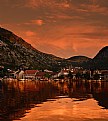Canvas has become the most common support medium for oil painting, replacing wooden panels. One of the earliest surviving oils on canvas is a French Madonna with angels from around 1410 in the Gemäldegalerie, Berlin. However, panel painting remained more common until the 16th century in Italy and the 17th century in Northern Europe. Mantegna and Venetian artists were among those leading the change; Venetian sail canvas was readily available and regarded as the best quality.
Canvas is typically stretched across a wooden frame called a stretcher, and may be coated with gesso before it is to be used; this is to prevent oil paint from coming into direct contact with the canvas fibers, which will eventually cause the canvas to decay. A traditional and flexible chalk gesso is composed of lead carbonate and linseed oil, applied over a rabbit skin glue ground; a variation using titanium white pigment and calcium carbonate is rather brittle and susceptible to cracking. As lead-based paint is poisonous, care has to be taken in using it. Various alternative and more flexible canvas primers are commercially available, the most popular being a synthetic latex paint composed of titanium dioxide and calcium carbonate, bound with a thermo-plastic emulsion. Many artists have painted onto unprimed canvas, such as Jackson Pollock[2], Kenneth Noland, Francis Bacon, Helen Frankenthaler, Dan Christensen, Larry Zox, Ronnie Landfield, Color Field painters, Lyrical Abstractionists and others.
Early canvas was made of linen, a sturdy brownish fabric of considerable strength. Linen is particularly suitable for the use of oil paint. In the early 20th century, cotton canvas, often referred to as "cotton duck", came into use. Linen is composed of higher quality material, and remains popular with many professional artists, especially those who work with oil paint. Cotton duck, which stretches more fully and has an even, mechanical weave, offers a more economical alternative. The advent of acrylic paint has greatly increased the popularity and use of cotton duck canvas. Linen and cotton derive from two entirely different plants, the flax plant and the cotton plant.
Gesso-ed canvases on stretchers are also available. These pre-stretched, pre-primed canvases are suitable for all but the most exacting professional standards. They are available in a variety of weights: light-weight is about 4 oz. or 5 oz.; medium-weight is about 7 oz. or 8 oz.; heavy-weight is about 10 oz. or 12 oz. They are prepared with two or three coats of gesso and are ready for use straight away. Artists desiring greater control of their painting surface may add a coat or two of their preferred gesso. Professional artists who wish to work on canvas may prepare their own canvas in the traditional manner.
One of the most outstanding differences between modern painting techniques and those of the Flemish and Dutch Masters is in the preparation of the canvas. "Modern" techniques take advantage of both the canvas texture as well as those of the paint itself. Renaissance masters took extreme measures to ensure that none of the texture of the canvas came through. This required a painstaking, months-long process of layering the raw canvas with (usually) lead-white paint, then polishing the surface, and then repeating.[3] The final product had little resemblance to fabric, but instead had a glossy, enamel-like finish. This flat surface was crucial in attaining photographic realism.
With a properly prepared canvas, the painter will find that each subsequent layer of color glides on in a "buttery" manner, and that with the proper consistency of application (fat over lean technique), a painting entirely devoid of brushstrokes can be achieved. A warm iron is applied over a piece of wet cotton to flatten the wrinkles.
Canvas can also be printed onto using offset or specialist digital printers to create canvas prints. This process of digital inkjet printing is popularly referred to as Giclée. After printing, the canvas can be wrapped around a stretcher and displayed.
[url=http://www.photo-print-on-canvas.com/]photos on canvas[/url]
|
















